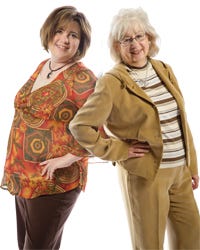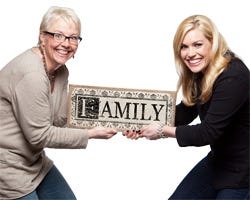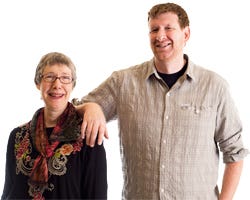
There’s no question about it: Running a natural products store is challenging. This is especially true for family-owned operations in which business hours bleed well past the 9-to-5 and boardroom issues crop up at the breakfast table. For many, it can be difficult to separate store life from home life. So when the time comes for one generation to pass the baton to the next, the process can be rife with complications and emotions on both sides. The stores and families that get this transition right share a commitment to business, ongoing communication and one another.
The training process
Because every family and business is unique, specific training and mentoring tactics vary greatly from store to store. But overall, the most successful training plans tend to involve either niche assignments or complete immersion—or a combination of the two.
Betsy Billingslea, owner of Houston-based Betsy’s Health Food, likes to say she’ll always be “the Betsy.” However, she has made room for son John and daughter-in-law Ramona by harnessing their individual strengths and carving out places for them in the business plan. Although she’s known that John would eventually take over the business since she opened her doors in 1993, for now the three work as a team, with each specializing in a different area. While Billingslea works with customers and handles ordering, John takes care of the bookkeeping, the business model and employee supervision as CEO. Ramona rounds out the team by handling advertising and marketing. “The three of us make the strategic decisions for the store together,” Billingslea says. “As owner, I can’t wear every single hat. It’s too big of a business. We are fortunate that we each have our role, we stick to it, and we don’t step on each other’s toes.”
Betsy.” However, she has made room for son John and daughter-in-law Ramona by harnessing their individual strengths and carving out places for them in the business plan. Although she’s known that John would eventually take over the business since she opened her doors in 1993, for now the three work as a team, with each specializing in a different area. While Billingslea works with customers and handles ordering, John takes care of the bookkeeping, the business model and employee supervision as CEO. Ramona rounds out the team by handling advertising and marketing. “The three of us make the strategic decisions for the store together,” Billingslea says. “As owner, I can’t wear every single hat. It’s too big of a business. We are fortunate that we each have our role, we stick to it, and we don’t step on each other’s toes.”
This is also the model in place at Soergel Orchards, a family farm and country store in Wexford, Pennsylvania. When the first generation passed ownership to their four sons and their wives, each couple owned a clean 25 percent of the business—and wore myriad hats each day to cover the many aspects of ownership. Now that eight of the children’s children have stepped back into the business, the division of labor is quite different, with each member of this third generation managing a separate area. “It has been incredibly beneficial for everyone to have their own niche,” says Beth Soergel, co-owner. “We are so diverse that I can’t see one person eventually overseeing it all.”
 Other stores and owners, though, hold the belief that nothing can replace complete immersion. This is a common approach among businesses that are passed on to an individual rather than to a group. Such is the case at Health Hut in Beaver Falls, Pennsylvania, where co-owners Kevin and Kelly Miller are grooming their daughter to one day take over the store. “Training has to include the top tier,” Kevin Miller says. “But there’s no facet of the business of which she shouldn’t have an intimate knowledge. Making sure the new generation can shovel the sidewalk, clean the toilets and floors, and do every aspect of the business is important. This allows her to discuss it, train it and show staff that, although she owns the business, she is no better.”
Other stores and owners, though, hold the belief that nothing can replace complete immersion. This is a common approach among businesses that are passed on to an individual rather than to a group. Such is the case at Health Hut in Beaver Falls, Pennsylvania, where co-owners Kevin and Kelly Miller are grooming their daughter to one day take over the store. “Training has to include the top tier,” Kevin Miller says. “But there’s no facet of the business of which she shouldn’t have an intimate knowledge. Making sure the new generation can shovel the sidewalk, clean the toilets and floors, and do every aspect of the business is important. This allows her to discuss it, train it and show staff that, although she owns the business, she is no better.”
Cambridge Naturals in Cambridge, Massachusetts, is taking a hybrid path in transitioning from first- to second-generation ownership after 41 years. According to co-founder and co-owner Michael Kanter, it’s important that daughter Emily learn all aspects of the business hands-on, from opening and closing to financial, personnel and repair issues. “Growing up in the business doesn’t mean she knows how to run it,” he says. But while it’s Kanter’s goal that Emily learn the entire business, he’s employing a niche approach. For example, Emily began handling marketing some time ago, and she currently runs the body care department. As she masters each area, new ones are added. Within her first year, the result will be a solid grasp of how the business is run on the ground.
Stepping back and stepping in
Regardless of what type of transition plan a store chooses, the true key to success is keeping minds and communication lines open. “It’s inherent in the second-generation dynamic to think all of your ideas are better than your parents’ and want to scrap everything you’ve been handed and do everything better,” says Abraham Nabors, second generation owner at Mustard Seed Market and Café in Akron and Solon, Ohio. “And while you want the future to be better, the way to make it that way is to take the best of what came before.” The Nabors family accomplishes this by consciously harnessing the strengths of each generation. For example, the generation passing ownership is often comprised of entrepreneurs who built the store from the ground up, Nabors says. “The entrepreneur is very different from the person who can grow a business or professionalize it,” he explains. “Those are two different skill sets and two different values. We try to bring out those values and differences to improve the mission.”
On the other side of the coin, firstgeneration owners may struggle with accepting changes  proposed by the second generation. “It’s not easy for parents to understand that your kids might have better ideas than you have,” Kanter admits. “I’m sure Emily is going to do things that we know are wrong, and they will turn out to be wrong. But I’m sure she’ll also do things we are certain are wrong, and they will turn out to be right. It’s my job to step back from that.”
proposed by the second generation. “It’s not easy for parents to understand that your kids might have better ideas than you have,” Kanter admits. “I’m sure Emily is going to do things that we know are wrong, and they will turn out to be wrong. But I’m sure she’ll also do things we are certain are wrong, and they will turn out to be right. It’s my job to step back from that.”
Debra Stark, founder of Debra’s Natural Gourmet in Concord, Massachussetts, knows a bit about stepping back. When her son Adam, now a second-generation co-owner, was a teenager, he requested that he and his mom work in the store together only one day per week. That desire may have been rooted in teenage frustrations, but it’s a work style that continues to benefit them today. “I try to let Adam develop his own strengths and be his own person,” Stark says. “My job as his mother has been to try to stay out of his way yet, as the founder of the store, to still point out what I want for the business. In the end, because of this approach, we appreciate each other’s intelligence and point of view.”
Staff considerations
Transitioning ownership is a milestone in the lives of the participating generations, but it can also trigger a huge shift for employees who have their own history with a store. So while role clarity and communication between generations remains critical, it is also important to diffuse  confusion among staff. For Stark, that meant sending out a storewide memo explaining Adam’s new role as co-owner. For Kanter, it entails showing the staff that Emily is putting in the sweat equity to learn the whole business. It also means rationing out time for her to connect with employees on her own. “We can tell the staff Emily’s history, but we know that some are likely to see her as being in a privileged position,” Kanter says. “So we want them to understand that this is serious and thoughtfully produced. We’re not just throwing someone into leadership.”
confusion among staff. For Stark, that meant sending out a storewide memo explaining Adam’s new role as co-owner. For Kanter, it entails showing the staff that Emily is putting in the sweat equity to learn the whole business. It also means rationing out time for her to connect with employees on her own. “We can tell the staff Emily’s history, but we know that some are likely to see her as being in a privileged position,” Kanter says. “So we want them to understand that this is serious and thoughtfully produced. We’re not just throwing someone into leadership.”
Nabors, who holds a dual role of co-owner and education coordinator, makes a concerted effort to let staff know which hat he’s wearing when discussing store issues. “I’ve always had a distaste for the label ‘owners’ son,’” says Nabors, explaining that the term implies a loose work ethic. “Inherently, that nepotism factor is never going to go away for my brother and me. I know that. But my goal is to make that irrelevant by showing how much value we can add to the company and how we legitimately perform in the roles we’re assigned.”
Bringing in reinforcements
When family tensions run high and the generational divide runs deep—or if families want to get ahead of such troubles—it can help to bring in an objective third party to mediate and even weigh in. The Kanters are lucky to have a son-in-law who is also a consultant. His role is to facilitate productive negotiation, and he has even implemented a series of workshops to help the family navigate the challenges of transition. As someone who didn’t grow up in the business, he also brings an outside perspective that is invaluable to the Kanters.
At Soergel Orchards, where there is one first-generation founder, eight second-generation owners and eight third-generation employees in the mix, it’s practically impossible for everyone to share the same exact viewpoint. That’s why they’ve tapped into the expertise of an outside consultant. For now, the eight co-owners are working with the consultant to come up with a common vision for the future before involving the third generation in these discussions. “These meetings can be heated and so emotionally charged at times,” Soergel says. “With family, it can be hard to take that emotional component out of the equation, and so often things get pushed under the rug. Having a mediator keeps all of us on our best behavior but also helps us say what we may have been afraid to say to one another. He helps us ask the right questions so we can answer them in a way that is honest and also respectful.”
About the Author
You May Also Like
.png?width=700&auto=webp&quality=80&disable=upscale)



